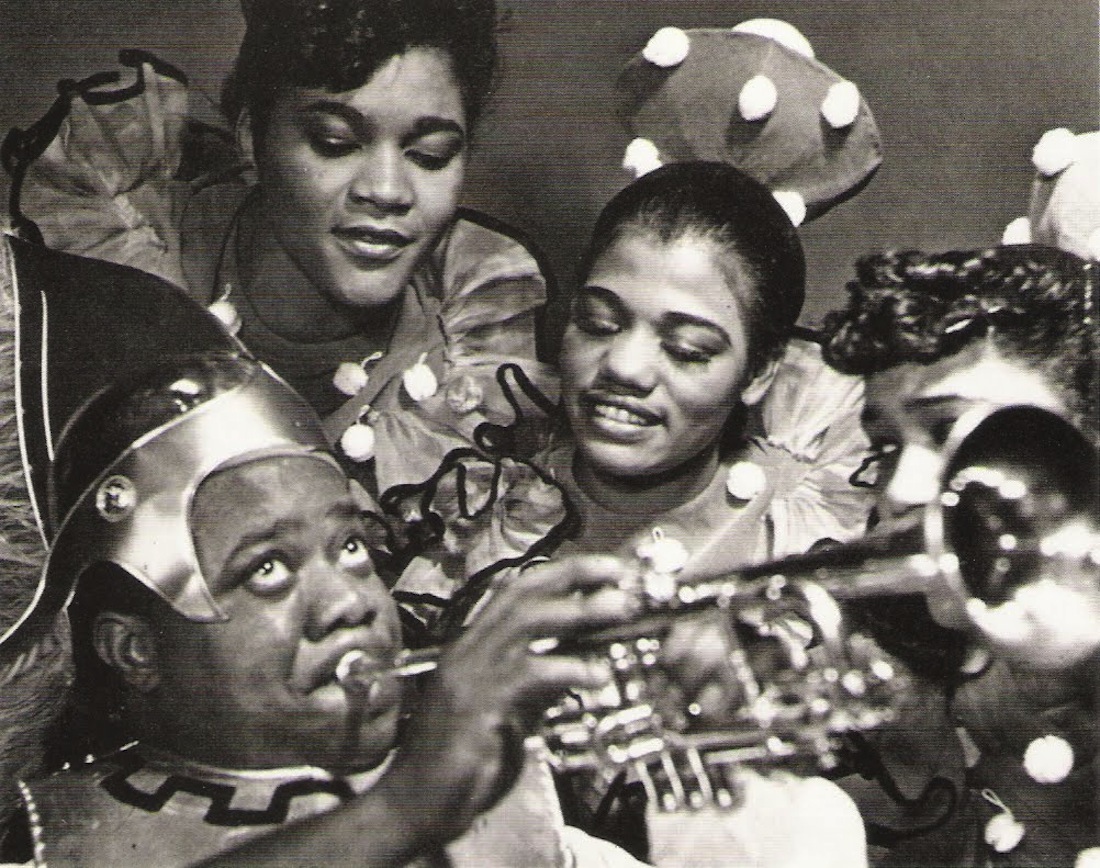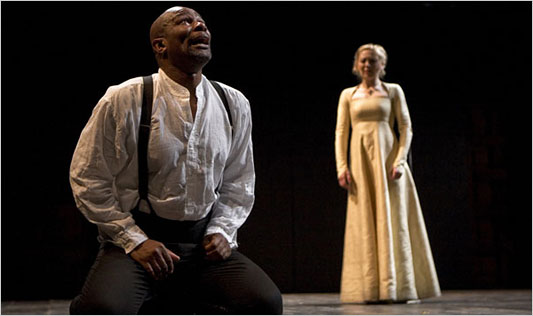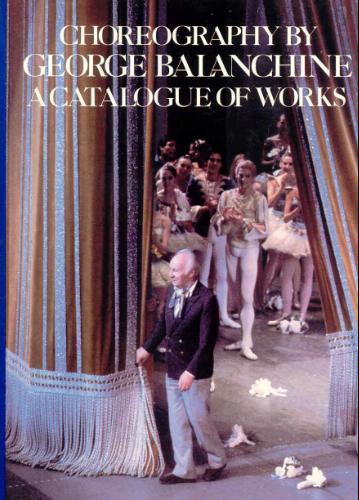“I have no ideas before I write a play. I have them when I have written the play or while I am not writing at all.”
Eugène Ionesco, Notes and Counter-Notes
Archives for January 2012
TT: A little taste
Here’s a publicity photo of John Douglas Thompson as Louis Armstrong in the upcoming Shakespeare & Company production of Satchmo at the Waldorf, shot by Kevin Sprague:
TT: Going to the show
 Shakespeare & Company of Lenox, Massachusetts, announced today that it will produce Satchmo at the Waldorf, my first play, in August. John Douglas Thompson, one of this country’s top classical actors and a longtime member of Shakespeare & Company, has been cast in the dual role of Louis “Satchmo” Armstrong, the greatest jazz musician of the twentieth century, and Joe Glaser, Armstrong’s mob-connected manager.
Shakespeare & Company of Lenox, Massachusetts, announced today that it will produce Satchmo at the Waldorf, my first play, in August. John Douglas Thompson, one of this country’s top classical actors and a longtime member of Shakespeare & Company, has been cast in the dual role of Louis “Satchmo” Armstrong, the greatest jazz musician of the twentieth century, and Joe Glaser, Armstrong’s mob-connected manager.
The director is Gordon Edelstein, the artistic director of New Haven’s Long Wharf Theatre, who staged the Roundabout Theatre Company’s production of Athol Fugard’s The Road to Mecca, which opens on Broadway next week. The show will be performed on the company’s main stage, the 413-seat Founders’ Theatre.
“No summer drama festival in America is more consistently satisfying than Shakespeare & Company,” I wrote in The Wall Street Journal in 2009. As for John, I agree wholeheartedly with Ben Brantley of the New York Times, who has called him “one of the most compelling classical stage actors of his generation,” and Gordon’s brilliantly original revivals of The Crucible, The Glass Menagerie, and Uncle Vanya all rank high on my short list of great nights at the theater.
 I’m seeing shows in Florida and wasn’t able to get up to Lenox for today’s announcement, so Elizabeth Aspenlieder, Shakespeare & Company’s publicist, asked me for a quote. Here’s what I told her:
I’m seeing shows in Florida and wasn’t able to get up to Lenox for today’s announcement, so Elizabeth Aspenlieder, Shakespeare & Company’s publicist, asked me for a quote. Here’s what I told her:
I’m still trying to get used to the idea that Shakespeare & Company is going to produce Satchmo at the Waldorf, much less that John is going to act in it and Gordon is going to stage it. I’m thrilled, honored, and astonished–all at once. I never dreamed that I’d have the chance to collaborate with such remarkable artists, or with a theater company whose work has meant so much to me for so long.
I’ll let you know more about the production as it continues to take shape. For now, I invite you to rejoice with me. This is a great day.
UPDATE: The company’s official season announcement is here.
Here’s the Berkshire Eagle‘s story about the press conference at which the production was announced.
* * *
The first photograph shows Louis Armstrong in costume as Bottom in Swingin’ the Dream, a musical version of A Midsummer Night’s Dream that ran briefly on Broadway in 1939. The second shows John Douglas Thompson and Juliet Rylance in Theater for a New Audience’s 2009 production of Othello.
TT: Almanac
“Every work of art (unless it is a psuedo-intellectualist work, a work already comprised in some ideology that it merely illustrates, as with Brecht) is outside ideology, is not reducible to ideology. Ideology circumscribes without penetrating it. The absence of ideology in a work does not mean an absence of ideas; on the contrary it fertilizes them.”
Eugène Ionesco, “A Reply to Kenneth Tynan: The Playwright’s Role”
TT: Here we are
This is the view from our porch. You could write a book here. Or a play. Or both. Or neither. Or you could just get over a cold:

TT: Retreat
I don’t want to talk about the past four days of my life. I don’t even want to think about them. Suffice it to say that I flew from New York to West Palm Beach on Thursday, saw a show there on Friday, flew back up to New York on Saturday to see Porgy and Bess on Broadway that same evening, then flew back down to the west coast of Florida the next morning. That is way too much time in the air, even for an old hand like me.
 No, it wasn’t a total loss. Nothing like it. In addition to seeing the new home of Palm Beach Dramaworks, one of my favorite regional theater companies, and dining at Havana before the show, I also got to say hello to my good friend Steven Caras, the great dance photographer. He even brought me a present, a signed archival copy of Last Bow, the best known of his countless photos, in which George Balanchine is seen taking the final curtain call of his long life.
No, it wasn’t a total loss. Nothing like it. In addition to seeing the new home of Palm Beach Dramaworks, one of my favorite regional theater companies, and dining at Havana before the show, I also got to say hello to my good friend Steven Caras, the great dance photographer. He even brought me a present, a signed archival copy of Last Bow, the best known of his countless photos, in which George Balanchine is seen taking the final curtain call of his long life.
It happens that I took part in the making of Steven Caras: See Them Dance, Deborah Novak’s 2011 film documentary about Steve’s life and work, and flew down to West Palm Beach last February to lend a hand with the first public screening, in return for which Steve promised to strike and sign a print of “Last Bow” for me. He delivered it on Friday, and I brought it back to New York with the utmost care the next day. Now it will occupy a place of honor in the Teachout Museum.
 So yes, things could have been a lot worse. That said, I was still greatly relieved when Mrs. T and I met at the Fort Myers airport on Sunday morning and headed straight for Sanibel Island, one of the prettiest and most tranquil places I know. Needless to say, I’m here for professional reasons–I’ve come to see Florida Rep‘s production of God of Carnage–but I also hope to write a chapter or two of Mood Indigo on the island and, if at all possible, get some much-needed rest.
So yes, things could have been a lot worse. That said, I was still greatly relieved when Mrs. T and I met at the Fort Myers airport on Sunday morning and headed straight for Sanibel Island, one of the prettiest and most tranquil places I know. Needless to say, I’m here for professional reasons–I’ve come to see Florida Rep‘s production of God of Carnage–but I also hope to write a chapter or two of Mood Indigo on the island and, if at all possible, get some much-needed rest.
For the record, we’re staying at the same unpretentiously comfortable place where we holed up last January, a stone’s throw away from the Gulf of Mexico, and we plan to spend as much time as we can walking on the beach and watching the sun set.
See you later.
* * *
The trailer for Steven Caras: See Them Dance:
TT: Just because
Tuesday in November, a documentary short subject released by the Office of War Information in 1945 for distribution in foreign countries, directed by John Berry and Nicholas Ray, written by Philip Dunne and Howard Koch, scored by Virgil Thomson, and produced by John Houseman:
(This is the latest in a series of arts-related videos that appear in this space each Monday and Wednesday.)
TT: Almanac
“Ideology is a specious way of relating to the world. It offers human beings the illusion of an identity, of dignity, and of morality while making it easier for them to part with them.”
Václav Havel, “The Power of the Powerless”
